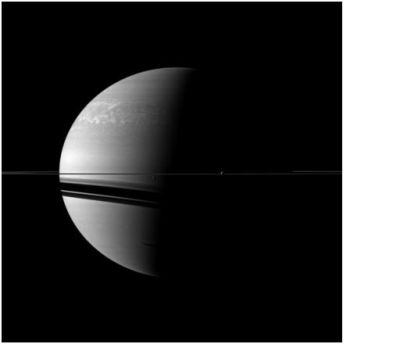16 June 2011

A Cassini spacecraft image, showing Saturn and two of its bizarre moons. Cassini was near the plane of Saturn’s rings, which are visible nearly edge-on. The shadows of the rings are visible as dark stripes, projected on Saturn’s orb.
Credit: NASA/JPL/Space Science Institute
NASA recently published a beautiful image of Saturn, the wonderful giant planet, acquired by the Saturn-orbiting Cassini spacecraft. The image shows Saturn, nearly half-lit, and two of its icy moons. The two moons, which are smaller than our Moon (3,476 km across), are dwarfed by their parent planet. They are, in order of size, Rhea (1,528 km across) and Dione (1,123 km across). Their names come from Greek mythology.
Both moons appear in the image as tiny crescents. Dione is visible near the center, while Rhea glows on the right. The shadows cast by Saturn’s magnificent rings are projected on the orb of Saturn, as dark bands. There is also the shadow of a third Saturnian moon, known as Tethys, seen near the bottom of the image, near the terminator between Saturn’s day and night sides. Tethys is not shown in the frame. Part of a huge storm, which has been swirling in Saturn’s northern hemisphere for months, is in the top left of the image.
The image was taken with Cassini’s wide-angle camera, on 11 March 2011, applying infrared filter. Cassini was approximately 2.9 million km from Saturn. The spacecraft was located just above the plane of the rings.
References
Dwarfed by Gas
http://photojournal.jpl.nasa.gov/catalog/PIA12769
Aymen Mohamed Ibrahem
Senior Astronomy Specialist